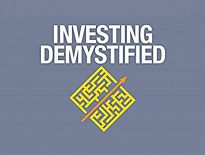Investing Demystified 5 – Everything Else

Today’s post is our fifth visit to a book that is popular with passive investors in the UK – Lars Kroijer’s Investing Demystified.
Contents
Lars Kroijer
Lars Kroijer’s book is increasingly popular on the UK finance subreddits.
- He has an economics degree from Harvard and an MBA from the business school there.
Until 2008, Lars was a hedge fund manager.
- He now works at Alliedcrowds.com, which “aggregates alternative capital into the world’s lower-income countries”.
Investing Demystified
Here’s a recap of what we’ve covered so far:
- Lars is a 100% passive investor, and pushes what I would call a “Lazy Portfolio” of only two funds.
- These are are sub-optimal, particularly for investors with larger portfolios.
- I see the appeal of lazy portfolios to novice investors, but that’s not the same as saying they are the best option.
- Lars thinks that markets are quite efficient, and the majority of people are not able to outperform them.
- Truly efficient markets would not exhibit simple outperformance factors like momentum, value, small size, low volatility and quality.
- Volatility parity portfolios with factor and trend-following overlays will outperform on a risk-adjusted basis.
- Lars thinks that we need only two assets – stocks and government bonds.
- Other bonds (international and corporate) are also allowed.
- I think there are many alternative assets that can add value to a portfolio.
- Commodities, private equity, VC, precious metals and hedge funds are obvious examples.
- The max SR portfolio will need to be juiced up to give higher returns by using a higher equities allocation.
- Lars likes market cap weighting.
- Market-cap weighted indices are by definition averages, and 50% of market participants should beat them (before costs).
- Market cap weighting is a poor way to construct an index, or to weight a portfolio.
- Equal weighting is better, and volatility parity is even better (across assets and geographies as well as within a single stock market).
- Market cap indices are inappropriate as benchmarks for private investors – you need your own benchmark that reflects the likely composition of your portfolio
- Lars is against home bias, and I am not.
- He is however in favour of “Away Bias” – a large allocation to the US.
- Lars objects to the idea that the future will be like the past.
- I would say that it’s the best data we have, and what is the alternative?
- Lars targets returns of 5% pa real from equities, which I think is a little optimistic.
- We agree on equity volatility of around 20%.
- Lars notes the great losses that are possible in stock markets, with two falls by more than 50% in the Dow since 1900, and another 6 falls between 40% and 50%.
- Recovery times for buy and hold range from 25 years for the 1929 crash to four years for the 2000 dot com bubble and the 2008 crisis.
- Of course, the Japanese market hasn’t yet recovered from the 1990s crash.
- Lars reiterates the importance of diversification, though he points out that it works least when you need it the most (correlations increase during crashes).
- Non-listed assets need to be taken into account when assigning portfolio weightings.
- Lars believes in lifestyling (more bonds as you age) but I think that you should stick with stocks into retirement.
- Lars also believes in the 4% rule, but in fact even those with a high equity allocation should not withdraw much more than 3% pa – see here.
- You should take a risk tolerance questionnaire, to work out what your exposure to equities might be – you can find ours here.
- We agree with Lars that costs matter and that taxes matter.
- Lars favours ETFs and index funds (a subset of OEICs) for implementing his portfolios.
- We prefer ETFs because we like to use listed assets with real-time pricing.
- Lars recommends threshold rebalancing, with 10% bands.
- 20% bands, checked every two weeks, are better, and cashflow rebalancing is best.
- Only sell stocks when you are above your target allocation and use a momentum filter.
- Lars recommends yearly reviews, but we say that you need to leave a minimum gap of 18 months to take advantage of trends.
Pensions
Lars like pensions for their tax relief, and – in the case of workplace pensions – free money from the employer.
Against that must be balanced:
- the restrictions on withdrawing money at a young age
- the tax you pay on the way out (including the dreaded LTA, if you are any good at investment)
- the (sometimes restricted) choice of investments within the plan
- possibly higher fees
Under some circumstances and durations, these drawbacks might outweigh the tax advantages, but I find this unlikely(at least in the UK).
Annuities
Lars has no problem with annuities.
- I do – they are terrible value for money in a low interest rate environment.
Insurance
Like me, Lars is against insurance, preferring to self-insure.
- This will save you money (the profits of the insurance company) on average.
Apocalypse investing
Black Swans and fat tails are phrases that were not much discussed before the 2008 financial crisis, but now everybody is familiar with them
- Bad financial events occur more frequently than the normal distribution assumed by theory would suggest.
In chapter 14, Lars looks at what might protect you in the bad times.
- Gold makes some sense, but where and how would you hold it?
Jewelry and arable land might be of some use in the event that there is a breakdown in society, but in my opinion, planning for extreme scenarios is a waste of time.
- Until you know exactly what’s gone wrong, you won’t know what you should have done about it.
Lars runs through the 2008 crisis, but I’m sure that the next one will have nothing in common with the last.
He also discusses how to avoid frauds like Bernie Madoff.
- In that particular case, avoiding steady returns created in a way that no-one understood would have done the trick.
In any case, Lars’s lazy portfolios are very unlikely to put you in harm’s way.
A financial wish list
The final chapter of the book is a list developments that Lars would like to see in the financial sector:
- Better (independent) comparison sites
- Better risk tolerance and management tools
- Better tax advice
- More customisation (specialisation) of ETF investing
These are fine, but I think there are more fundamental problems to solve:
- Getting people to live within their means so that they have money to save.
- Persuading people that cash is a terrible long-term investment.
Conclusions
And that’s it – we’ve made it through the book.
- Today we agreed about pensions and insurance, but not about annuities.
I’ll be back in a few weeks with a summary of the entire work.
- Until next time.















